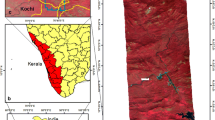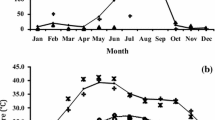Abstract
Nitrogen (N) is a major constituent element of chlorophyll and thylakoid proteins in the plant canopy. The amount of foliar nitrogen reflects the growth of vegetation as it affects the photosynthetic process and the interaction of electromagnetic radiation with canopy. Non-destructive approach using space-borne hyperspectral remote sensing has shown potential in estimating the nitrogen content in leaves. This study used hyperspectral image from Hyperion sensor to indicate the strand growth and vigor of Shorea robusta (Sal) forest in Doon Valley by estimating foliar nitrogen. Identification of sampling sites was done in a Sal forest patch of area (270 ha) using crown closure information based on LAI measurement. High spatial resolution satellite data, RapidEye was used for LAI mapping using ground truth data. Leaf spectra using field spectroradiometer, as well as leaf samples were collected from each sample site. The different red edge indices derived from Hyperion data were correlated against laboratory analyzed leaf nitrogen mass. Amongst these indices, Modified Normalized Difference Red Edge (MNDRE) index showed highest correlation coefficient (r = 0.89) with nitrogen mass. For generating spatial nitrogen mass map, regression equation was developed based on MNDRE index. Predicting potential of satellite based MNDRE was validated from field based spectra, as showed r = 0.91. Spatially depicted nitrogen information using hyperspectral satellite image, is one of the first demonstration of the work carried out in the tropical species of Himalaya. Spatial N distribution map has potential to be used in predicting carbon sequestration potential and disturbances caused due to pest-insect infestation, anthropogenic pressure and site degradation.






Similar content being viewed by others
References
Evans JR (1989) Photosynthesis and nitrogen relationships in leaves of C 3 plants. Oecologia 78(1):9–19
Kursar TA, Coley PD (1991) Nitrogen content and expansion rate of young leaves of rain forest species: implications for herbivory. Biotropica 23:141–150
Field C, Mooney HA (1986) The photosynthesis–nitrogen relationship in wild plants. In: Givnish T (ed) On the economy of plant form and function. Cambridge University Press, Cambridge, pp 22–55
Curran PJ (1989) Remote sensing of foliar chemistry. Remote Sens Environ 30(3):271–278
Tripathi SK, Singh KP (2001) Ecological responses of dry tropical forest and savanna ecosystems to nutrient enrichment. Environ Agric Biodivers Agric Pollut South Asia 2:150
Evans JR (1996) Developmental constraints on photosynthesis: effects of light and nutrition. Photosynthesis and the environment. Springer, Netherlands, pp 281–304
Stone C, Haywood A (2006) Assessing canopy health of native eucalypt forests. Ecol Manag Restor 7:1
Mu X, Chen Q, Chen F, Yuan L, Mi G (2016) Within-leaf nitrogen allocation in adaptation to low nitrogen supply in maize during grain-filling stage. Front Plant Sci 7:699
Trumbore S, Brando P, Hartmann H (2015) Forest health and global change. Science 349(6250):814–818
Goetz AFH, Vane G, Solomon JE, Rock BN (1985) Imaging spectrometry for Earth remote sensing. Science 228(4704):1147–1153
Gómez-Casero MT, López-Granados F, Peña-Barragán JM, Jurado-Expósito M, García-Torres L, Fernández-Escobar R (2007) Assessing nitrogen and potassium deficiencies in olive orchards through discriminant analysis of hyperspectral data. J Am Soc Hortic Sci 132(5):611–618
Zhai Y, Cui L, Zhou X, Gao Y, Fei T, Gao W (2013) Estimation of nitrogen, phosphorus, and potassium contents in the leaves of different plants using laboratory-based visible and near-infrared reflectance spectroscopy: comparison of partial least-square regression and support vector machine regression methods. Int J Remote Sens 34(7):2502–2518
Karimi Y, Prasher SO, Madani A, Kim S (2008) Application of support vector machine technology for the estimation of crop biophysical parameters using aerial hyperspectral observations. Can Biosyst Eng 50(7):13–20
Coops NC, Smith ML, Martin ME, Ollinger SV (2003) Prediction of eucalypt foliage nitrogen content from satellite-derived hyperspectral data. IEEE Trans Geosci Remote 41(6):1338–1346
Knyazikhin et al (2013) Hyperspectral remote sensing of foliar nitrogen content. Proc Natl Acad Sci USA 110(3):E185–E192
Amirruddin AD, Muharam FM, Zaharah AR (2014) Evaluation of multiple proximal sensors for estimating nitrogen nutritional content of matured oil palm. Asian J Plant Sci 13(4/8):136–146
Pellissier PA, Ollinger SV, Lepine LC, Palace MW, McDowell WH (2015) Remote sensing of foliar nitrogen in cultivated grasslands of human dominated landscapes. Remote Sens Environ 167:88–97
Lepine LC, Ollinger SV, Ouimette AP, Martin ME (2016) Examining spectral reflectance features related to foliar nitrogen in forests: implications for broad-scale nitrogen mapping. Remote Sens Environ 173:174–186
Martin S (2011) Hyperspectral remote sensing application for vegetation studies. In: Navalgund RR, Ray SS (eds) Hyperspectral data, analysis techniques and applications. Bishen Singh Mahendra Pal Singh, Dehradun, pp 79–98
Kanke Y, Raun W, Solie J, Stone M, Taylor R (2012) Red edge as a potential index for detecting differences in plant nitrogen status in winter wheat. J Plant Nutr 35(10):1526–1541
Filella I, Penuelas J (1994) The red edge position and shape as indicators of plant chlorophyll content, biomass and hydric status. Int J Remote Sens 15(7):1459–1470
Sharma LK, Bu H, Denton A, Franzen DW (2015) Active-optical sensors using red NDVI compared to red edge NDVI for prediction of corn grain yield in North Dakota, USA. Sensors 15(11):27832–27853
Mandal G, Joshi SP (2014) Analysis of vegetation dynamics and phytodiversity from three dry deciduous forests of Doon Valley, Western Himalaya, India. J Asia-Pac Biodivers 7(3):292–304
Chauhan PS, Porwal MC, Sharma L (2003) Change detection in Sal forest in Dehradun forest division using remote sensing and geographical information system. J Indian Soc Remote Sens 31(3):211–218
Gong P, Pu R, Biging GS, Larrieu MR (2003) Estimation of forest leaf area index using vegetation indices derived from Hyperion hyperspectral data. IEEE Trans Geosci Remote 41(6):1355–1362
Mueller-Dombois D, Ellenberg H (1974) Aims and methods of vegetation ecology, vol 81. Wiley, New York
Clevers JG, Gitelson AA (2013) Remote estimation of crop and grass chlorophyll and nitrogen content using red-edge bands on Sentinel-2 and-3. Int J Appl Earth Obs 23:344–351
Guyot G, Baret F, Major DJ (1988) High spectral resolution: Determination of spectral shifts between the red and the near infrared. Int Arch Photogram Remote Sens 11:750–760
Vogelmann JE, Rock BN, Moss DM (1993) Red edge spectral measurements from sugar maple leaves. Remote Sens 14(8):1563–1575
Gitelson AA, Merzlyak MN (1996) Signature analysis of leaf reflectance spectra: algorithm development for remote sensing of chlorophyll. J Plant Physiol 148(3–4):494–500
Barnes EM, Clarke TR, Richards SE, Colaizzi PD, Haberland J, Kostrzewski M, Waller P, Choi C, Riley E, Thompson T, Lascano RJ, Li H, Moran MS (2000) Coincident detection of crop water stress, nitrogen status and canopy density using ground based multispectral data [CD ROM]. In: Proceedings of the fifth international conference on precision agriculture, Bloomington, MN, USA, 16–19 July 2000
Sims DA, Gamon JA (2002) Relationships between leaf pigment content and spectral reflectance across a wide range of species, leaf structures and developmental stages. Remote Sens Environ 81(2):337–354
Herrmann I, Pimstein A, Karnieli A, Cohen Y, Alchanatis V, Bonfil DJ (2010) Assessment of leaf area index by the red-edge inflection point derived from VENμS bands. In: Proceedings of the ESA hyperspectral workshop, Frascati, Italy, vol 683, pp 1–7
Hirose T, Werger MJA, Pons TL, Van Rheenen JWA (1988) Canopy structure and leaf nitrogen distribution in a stand of Lysimachia vulgaris L. as influenced by stand density. Oecologia 77(2):145–150
Muñoz-Huerta RF, Guevara-Gonzalez RG, Contreras-Medina LM, Torres-Pacheco I, Prado-Olivarez J, Ocampo-Velazquez RV (2013) A review of methods for sensing the nitrogen status in plants: advantages, disadvantages and recent advances. Sensors 13(8):10823–10843
Maschinski J, Whitham TG (1989) The continuum of plant responses to herbivory: the influence of plant association, nutrient availability, and timing. Am Nat 134(1):1–19
Bryant L (2015) Organic matter can improve your soil’s water holding capacity. NRDC Switchboard May, 27
Singh D, Singh S, Krishna Murthy YVN, Lakshmi VR (2014) Assessment of foliar biochemicals in tropical, subtropical and temperate ecosystems of Lesser Himalayas. Int J Ecol Environ Sci 40(4):205–218
Li F, Miao Y, Feng G, Yuan F, Yue S, Gao X, Liu Y, Liu B, Ustin SL, Chen X (2014) Improving estimation of summer maize nitrogen status with red edge-based spectral vegetation indices. Field Crops Res 157:111–123
Mutanga O, Adam E, Adjorlolo C, Abdel-Rahman EM (2015) Evaluating the robustness of models developed from field spectral data in predicting African grass foliar nitrogen concentration using WorldView-2 image as an independent test dataset. Int J Appl Earth Obs Geoinf 34:178–187
Tarpley L, Reddy KR, Sassenrath-Cole GF (2000) Reflectance indices with precision and accuracy in predicting cotton leaf nitrogen concentration. Crop Sci 40(6):1814–1819
Wullschleger SD, Epstein HE, Box EO, Euskirchen ES, Goswami S, Iversen CM, Kattge J, Norby RJ, van Bodegom PM, Xu X (2014) Plant functional types in Earth system models: past experiences and future directions for application of dynamic vegetation models in high-latitude ecosystems. Ann Bot 114(1):1–6
Aspen Center for Environmental Studies (ASES) (2017). http://foresthealthindex.org. Accessed 8 July 2017
Acknowledgements
The authors acknowledge the financial support by Department of Space, Govt. of India for carrying out this work. Thanks are due to Director IIRS for his constant encouragement and motivation for carrying out this work. Authors are also thankful to SkyMap Global India Pvt. Ltd. who helped us and given free of cost RapidEye tiles for our research work.
Author information
Authors and Affiliations
Corresponding author
Rights and permissions
About this article
Cite this article
Bandyopadhyay, D., Bhavsar, D., Pandey, K. et al. Red Edge Index as an Indicator of Vegetation Growth and Vigor Using Hyperspectral Remote Sensing Data. Proc. Natl. Acad. Sci., India, Sect. A Phys. Sci. 87, 879–888 (2017). https://doi.org/10.1007/s40010-017-0456-4
Received:
Revised:
Accepted:
Published:
Issue Date:
DOI: https://doi.org/10.1007/s40010-017-0456-4




